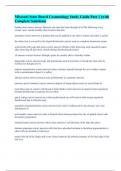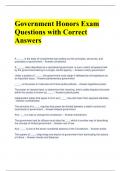Chapter 01
Introduction
Multiple Choice Questions
1. The firm's information system:
A. is always a single integrated system
B. includes only financial information
C. may include other information such as customer satisfaction surveys, in addition to financial
information
D. is less important as a firm grows in size
E. none of the above
2. Identify all the correct statements:
A. Managers naturally seek to maximize shareholders' wealth
B. Managers act in their own interests, and so there is no way to align their interests with those of
the owners
C. To motivate managers in non-profit firms, no employee incentives are needed
D. To align the interests of managers and owners, owners must design systems to monitor and
reward management behavior that increases the firm's profits
E. none of the above
,3. An internal accounting system should:
A. provide information to enable costs to be minimized
B. provide financial accounting data for external reporting purposes
C. provide management accounting information for decision-making
D. provide data for tax purposes
E. all of the above
4. Economic Darwinism:
A. explains why firms persist in inefficient behavior
B. explains why some inefficient accounting practices persist
C. explains why marmots eat bears
D. explains why bears eat marmots
E. none of the above
5. Management accountants:
A. are internal consultants
B. are mainly score-keepers
C. focus on calculating product costs
D. are ‘corporate cops'
E. mostly a) and d)
6. Internal control systems:
A. are the responsibility of the external auditor
B. include anti-fraud measures
C. are designed to allow financial misrepresentation
D. require that one person perform all aspects of a task
E. all of the above
,7. Performance measures:
A. are critical in designing a reward system
B. are unimportant in designing a reward system
C. always influence people to achieve them
D. are always worded vaguely
E. are not needed to provide incentives because employees always want to do the right thing
8. Micro Enterprises has the capacity to produce 10,000 widgets a month, and currently makes and
sells 9,000 widgets a month. Widgets normally sell for $6 each, and cost an average of $5 to make,
including fixed costs. The monthly fixed costs are $18,000. Coyote Corp. has offered to buy 1,000
widgets at $4 each.
What is the "cost" per unit in the context of evaluating the offer from Coyote Corp.?
A. $2
B. $3
C. $4
D. $5
E. $6
9. Micro Enterprises has the capacity to produce 10,000 widgets a month, and currently makes and
sells 9,000 widgets a month. Widgets normally sell for $6 each, and cost an average of $5 to make,
including fixed costs. The monthly fixed costs are $18,000. Coyote Corp. has offered to buy 1,000
widgets at $4 each.
On this information alone, should Micro accept the offer?
A. No, because it will lose $1 per unit
B. No, because it will lose $2 per unit
C. No, because it will exceed capacity
D. Yes, because it makes $1 per unit in the short run
E. Unable to determine
, 10. Micro Enterprises has the capacity to produce 10,000 widgets a month, and currently makes and
sells 9,000 widgets a month. Widgets normally sell for $6 each, and cost an average of $5 to make,
including fixed costs. The monthly fixed costs are $18,000. Coyote Corp. has offered to buy 1,000
widgets at $4 each.
What other factors should be taken into consideration?
A. The impact on the normal selling price of $6
B. Will an additional shift be needed to complete the order?
C. Are future orders from Coyote likely?
D. Does the special price comply with the Robinson-Patman Act?
E. All of the above
11. Micro Enterprises has the capacity to produce 10,000 widgets a month, and currently makes and
sells 9,000 widgets a month. Widgets normally sell for $6 each, and cost an average of $5 to make,
including fixed costs. The monthly fixed costs are $18,000. Coyote Corp. has offered to buy 1,000
widgets at $4 each.
Assuming the same story, but Coyote's offer is for 1,500 units (all or nothing), should the offer be
accepted?
A. No, because it will lose $1 per unit
B. No, because the opportunity costs outweigh the gains
C. No, (indifferent or worse) because the opportunity costs equal the gains
D. Yes, because it makes $1 per unit in the short run
E. Unable to determine
Essay Questions




